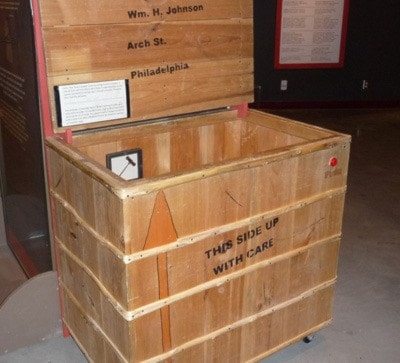Henry “Box” Brown was a 19th Century Virginia slave who mailed himself to Philadelphia abolitionists in a desperate bid for freedom.
He spent 26 hours hidden in a wooden crate during transport, using a hand-powered drill to make air holes so he could breathe during the perilous journey.
He went on to become an outspoken figure in the fight against slavery.
Brown’s remarkable journey is just one of the eye-opening stories along the Underground Railroad, a network of secret routes and safe houses used by black U.S. slaves to escape to freedom in northern states and Canada.
Passages to Freedom, a traveling exhibit at the Surrey Museum to the end of May, introduces some of the personalities along the Underground Railway, and delves into the lives of slaves through narratives, models, music and interactive displays.
Some 40,000 black refugees crossed into Canada before the American Civil War, arriving mostly in southwest Ontario.
Their journeys were assisted by black and white abolitionists. The fugitives relied on signs, codes and symbols masquerading as everyday objects such as quilts, tea towels and even lawn statues that helped guide the way.
Clues were hidden in the open, such as the old spiritual song that advised, “Follow the drinking gourd”, a line that actually referred to the Big Dipper constellation in the night sky, pointing the route north.
The exhibit, developed by the Welland Historical Museum in Southern Ontario with the assistance of Heritage Canada, the Peterborough Centennial Museum and others, points out just how dangerous the journey was, and how much was at stake for anyone involved.
In 1850, a new U.S. fugitive slave law meant slave owners could recapture runaways in northern free states. Anyone assisting a runaway could be jailed for six months. Federal marshals were required to arrest anyone believed to be a runaway, meaning slave owners could claim any black person as his escaped slave.
There was an influx of people into eastern Canada. Even so, bounty hunters often crossed into Canada to kidnap and sell people into slavery, a devastating proposition, as Passages to Freedom reveals.
Slaves on plantations lived in appalling conditions and had no rights or avenue for self-determination, providing a cheap labour force for cotton plantations and forming the foundation of the colonial economy.
“[The mush] was put into a large wooden tray or trough, and set down upon the ground,” reads a passage by Frederick Douglass, a leading spokesman for the abolition of slavery. “The children were then called, like so many pigs... they would come and devour the mush, some with oyster shells, others with pieces of shingle, some with naked hands, and none with spoons. He that ate fastest got most...”
Homes were windowless, overcrowded log huts with dirt floors, a stark contrast to the luxury of the planation house at the centre of it all.
“We lodged in log huts and on the bare ground. Wooden floors were an unknown luxury. In a single room were huddled, like cattle, 10 or a dozen persons...” reads a quote by Josiah Henson.
The exhibit presents other startling facts: Women slaves were not allowed to legally name the father of their children; eight of the first 12 U.S. presidents were slave owners; visitors may also be surprised to learn that slavery was legalized in French Canada in 1689. Within a century, there were more than 300 slaves in the Niagara region.
In 1793, the first anti-slavery act in the British Empire prevented further importation of slaves into Upper Canada, but allowed slave owners to hold those already in their possession until the slave was granted freedom at age 25.
The Surrey Museum is located at 17710 56A Avenue. It’s open Tuesdays to Fridays from 9:30 a.m. to 5:30 p.m., and Saturdays from 10 a.m. to 5 p.m. Admission for 2011 is sponsored by the Friends of the Surrey Museum Society. For more information, call 604-592-6956 or visit surrey.ca/heritage.
